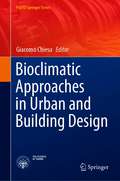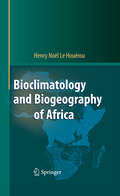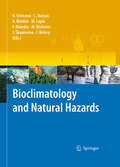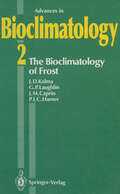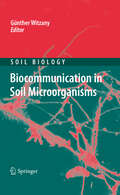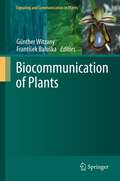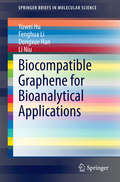- Table View
- List View
Biochemistry of Beer Fermentation (SpringerBriefs in Biochemistry and Molecular Biology)
by Eduardo Pires Tomáš BrányikBeer is the most popular alcoholic beverage in the world. Yet, behind each glass of beer there is an enormous amount of work invested. If the first image that comes to your mind is the lifting of heavy bags of malt or carrying kegs, guess again! Most of the work involved in brewing is carried out by “microworkers” – yeast and their enzymes! These special helpers are responsible for catalyzing the vast majority of the biochemical reactions occurring in all steps that gradually transform the sugary wort into beer. This book not only provides readers with an overview of the whole biochemical process involved in beer fermentation, but also reviews the latest findings in this delightful field, making it essential reading for both scientists and brewing enthusiasts
Biochemistry of Drug Resistance
by Sarfraz Ahmed Suvash Chandra Ojha Muhammad Najam-ul-Haq Muhammad Younus Muhammad Zaffar HashmiThis book provides a comprehensive discussion on the current information and evidence on the latest developments in the field of drugs resistance. Drug resistance is the reduction in effectiveness of a medication such as an antimicrobial or an antineoplastic in treating a disease or condition. This leads to negative outcomes at great risk of public health; therefore, increasing efforts are dedicated to the development of a new generation of medications that will help deal with this phenomenon. Decades of technological innovations in drug design have demonstrated the potential of resistance. Enormous information on various aspects of antibiotics resistance is available. However, literature on drug resistance specifically related to infectious and non-infectious diseases is rarely presented, particularly those focusing on the mechanisms, biochemistry, kinetics, dynamics, and management of drug resistance. Therefore, there is an immense need for a systematic compilation on the available information about this issue. All the chapters are logically selected and arranged to provide state-of-the-art information about all aspects of drugs resistance. After an introductory chapter, four chapters are dedicated to infectious microbial diseases, whereas two other chapters are complimenting this theme and focusing on drugs resistance in ear, nose and throat, and skin diseases. The recent advances in the understanding of drugs resistance in lung, neurological, kidney, heart, and liver diseases are also covered. Biochemistry of drugs resistance in cancer, HIV, ocular, reproductive, and diabetes diseases is also discussed. Finally, a chapter dedicated to the “management of drug resistance” has been included.
Biochemistry of food proteins
by B. J. HudsonDevelopments in the understanding of food protein structure, behaviour and applications continue apace. Many of these have, in the past decade, been reported and evaluated in the series 'Developments in Food Pro teins' , comprising seven volumes, with a total of 55 chapters. The time has now come to re-assess many of the topics reviewed in that series and to add certain others. However, instead of assembling, some what at random, food protein topics from quite disparate fields in indi vidual volumes, we have decided to bring together homogeneous groups of topics, each representing a specific sector of the subject. Under the general theme of 'Progress in Food Proteins' the first of these groups covers 'Biochemistry' . Readers will note that, though six of the topics reviewed in this volume are new, five of them have already featured in 'Developments in Food Proteins'. These last are in active research fields in which new develop ments have been of special significance. In this sense, therefore, they are welcome updates.
Biochemistry of Fruit Ripening
by G. B. Seymour J. E. Taylor Gregory A. TuckerIt is over 20 years since the publication of A.c. Hulme's two volume text on The Biochemistry of Fruits and thei.r Products. Whilst the bulk of the information contained in that text is still relevant it is true to say that our understanding of the biochemical and genetic mech
Biochips: Technology and Applications (Biological and Medical Physics, Biomedical Engineering)
by Wan-Li Xing Jing ChengThis book brings together contributions from internationally renowned experts in the biochip field. The authors present not only their latest research work, but also discuss current trends in biochip technology. Specific topics range from microarray technology and its applications to lab-on-a-chip technology.
Biochips and Medical Imaging
by Shan Xiang Wang Adam de la ZerdaAdvanced, recent developments in biochips and medical imaging Biochips and Medical Imaging is designed as a professional resource, covering recent biochip and medical imaging developments. Within the text, the authors encourage uniting aspects of engineering, biology, and medicine to facilitate advancements in the field of molecular diagnostics and imaging. Biochips are microchips for efficiently screening biological analytes. This book aims at presenting information on the state-of-the-art and emerging biosensors, biochips, and imaging devices of the body&’s systems, including the endocrine, circulatory, and immune systems. Medical diagnostics includes biochips (in-vitro diagnostics) and medical and molecular imaging (in-vivo imaging). Biochips and Medical Imaging explores the role of in-vitro and in-vivo diagnostics. It enables an instructor to share in-depth examples of the use of biochips in diagnosing cancer and cardiovascular diseases. Provides real-life knowledge on biochips and medical imaging, written by leading researchers Serves as a resource for professionals working in the biochip or imaging fields Features an accessible approach for anyone interested in biochips and their applications Readers of Biochips and Medical Imaging can expand their knowledge of medical technology, even if they have no biological knowledge and a limited math background. With its focus on important developments, this book is sure to also capture the interest of bioengineering and biomaterials scientists, structural biologists, electrical engineers, and nanotechnologists.
Biochips and Medical Imaging
by Shan Xiang Wang Adam de la ZerdaAdvanced, recent developments in biochips and medical imaging Biochips and Medical Imaging is designed as a professional resource, covering recent biochip and medical imaging developments. Within the text, the authors encourage uniting aspects of engineering, biology, and medicine to facilitate advancements in the field of molecular diagnostics and imaging. Biochips are microchips for efficiently screening biological analytes. This book aims at presenting information on the state-of-the-art and emerging biosensors, biochips, and imaging devices of the body&’s systems, including the endocrine, circulatory, and immune systems. Medical diagnostics includes biochips (in-vitro diagnostics) and medical and molecular imaging (in-vivo imaging). Biochips and Medical Imaging explores the role of in-vitro and in-vivo diagnostics. It enables an instructor to share in-depth examples of the use of biochips in diagnosing cancer and cardiovascular diseases. Provides real-life knowledge on biochips and medical imaging, written by leading researchers Serves as a resource for professionals working in the biochip or imaging fields Features an accessible approach for anyone interested in biochips and their applications Readers of Biochips and Medical Imaging can expand their knowledge of medical technology, even if they have no biological knowledge and a limited math background. With its focus on important developments, this book is sure to also capture the interest of bioengineering and biomaterials scientists, structural biologists, electrical engineers, and nanotechnologists.
Bioclimatic Approaches in Urban and Building Design (PoliTO Springer Series)
by Giacomo ChiesaThis book explores the bioclimatic approach to building design. Constant innovations in the field are evident, including the need to face climate changes and increase the local resilience at different scales (regional, urban, architectural). Differently from other contributions, this book provides a definition of the bioclimatic design approach following a technological and performance-driven vision. It includes one of the largest collection of research voices on the topic, becoming also a critical reference work for bioclimatic theory. It is intended for architects, engineers, researchers, and technicians who have professional and research interests in bioclimatic and in sustainable and technological design issues.
Bioclimatic Architecture in Warm Climates: A Guide for Best Practices in Africa
by Manuel Correia Guedes Gustavo CantuariaThis book provides a comprehensive, hands-on approach to bioclimatic building design in Africa. Bioclimatic design is at the core of urban sustainability, and is a critical issue in Africa, where “imported” building typologies are being used at an increasing pace, disregarding the local context and consequently causing damage to the environment, to the economy, and to the culture itself. This book provides a concise set of sustainable design guidelines to be applied in both new buildings and the refurbishment of old buildings, and integrates bioclimatic design strategies with other sustainability issues such as: cultural aspects, affordability, and urban planning. Chapters are fully illustrated with photographs and drawings and include best-practice examples and strategies making it accessible to engineers, architects, students and a broad range of professionals in the building industry. Encompasses all climatic regions in Africa;Integrates bioclimatic design strategies with other sustainability issues;Discusses new design to refurbishment, from urban to rural, including office buildings, residential, tourism, social housing and self building.
Bioclimatology and Biogeography of Africa
by Henry N. HouérouCovering an area of over 130 million km2 spanning the Mediterranean, equator and tropics, the African continent features a spectacular geographic diversity. Consequently, it is characterised by extremely variable climatic, edaphic and ecological conditions, associated with a wide range of natural vegetation and wildlife, as well as human population density, crops and livestock. In this book, Henry Le Houérou presents his bioclimatic and biogeographic classification of Africa. The extensive data provide the basis for comparisons between various African regions, and with regions on other continents such as Latin America or the Indian subcontinent. The results constitute a rational basis for national, regional and sub-regional rural development planning, and for agricultural research dealing with aspects such as plant and animal introductions, the extrapolation or interpolation of experimental or developmental findings, and ecosystems dynamics. Possible problems of applications are also examined.
Bioclimatology and Natural Hazards
by Katarína Strelcová Miroslav Blazenec Jan Holecy Axel Kleidon Milan Lapin Frantisek Matejka Csaba Matyas Jaroslav SkvareninaAnthropogenic influences to the earth's system, including the atmosphere, hydrosphere, biosphere, cryosphere and lithosphere, represent a serious challenge to our planet's ecosystems and natural environments. Bioclimatology, hydrology, bio-hydrology and eco-physiology are important scientific research areas with wide application to environmental protection, forestry, agriculture and water management, and protection against natural hazards including droughts, floods, windstorms, weather extremes, and wild fires. Bioclimatology helps to better understand the causes and impacts of natural hazards and how to prevent them. Improved knowledge of natural hazards is a vital prerequisite for the implementation of integrated resource management. It provides a useful framework for combating current climate variability and for adapting to ongoing climate change. This book presents research on the interactions between meteorological, climatological, hydrological and biological processes in the atmospheric and terrestrial environment. It highlights a spectrum of topics associated with climate change and weather extremes and their impact on different economic sectors. The contributing authors come from renowned scientific research institutions and universities and specialise in issues of climate change, soil-plant-atmosphere interactions, hydrologic cycle, ecosystems, biosphere, and natural hazards.
The Bioclimatology of Frost: Its Occurrence, Impact and Protection (Advances in Bioclimatology #2)
by J. D. Kalma G. P. Laughlin J. M. Caprio P.J.C. HamerThe economic costs of frosts in agriculture and horticulture in many parts of the world can be very significant. Reports in the media include accounts on how frosts have devastated coffee crops in Brazil or in Papua New Guinea, and how frosts have seriously damaged the Florida citrus industry. Frost may cause losses in current harvests or a decline in future yields through more permanent damage to trees and bushes. Damaging frosts may occur as infrequent, short-term events with sub-zero temperatures or with unusually severe winter temperatures which extend over long periods. In this book we have aimed at providing a comprehensive review of recent advances in the area of frost research. The stimulus for writing this book has come from the recognition that there is a shortage of recent texts which deal exclusively with the bioclimatology of frost. Bioclimatology deals with the relations between climate and life and the present text is particularly concerned with the effects of low temperatures on plants. Our purpose has been to assist researchers, engineers, extension officers and students in understanding the physical aspects of frost occurrence and frost distribution as well as the biological and phenological aspects of frost damage and to provide an overview of direct and indirect methods of frost pro tection and prevention.
Biocoating for Fertilizer Industry (SpringerBriefs in Applied Sciences and Technology)
by Husnul Azan Tajarudin Charles Wai NgThis book presents the advancement of coating materials technology especially in agriculture, particularly for fertilizers. Fertilizers are a critical component in meeting rising demands and ensuring global food security. A new generation of fertilizers made by coating granules with biopolymers address these issues. Coating in agriculture is an important area in research for a more sustainable future. Many examples and instances from existing research and related research gaps are discussed. It includes applications of composites as fertilizer’s coating, advantages and disadvantages of fertilizer coating from composites, applications of bacteria in composite, applications of bacteria in fertilizer industry as well as the common techniques of coating fertilizers with drying process.
Biocommunication in Soil Microorganisms (Soil Biology #23)
by Günther WitzanyCommunication is defined as an interaction between at least two living agents which share a repertoire of signs. These are combined according to syntactic, semantic and context-dependent, pragmatic rules in order to coordinate behavior. This volume deals with the important roles of soil bacteria in parasitic and symbiotic interactions with viruses, plants, animals and fungi. Starting with a general overview of the key levels of communication between bacteria, further reviews examine the various aspects of intracellular as well as intercellular biocommunication between soil microorganisms. This includes the various levels of biocommunication between phages and bacteria, between soil algae and bacteria, and between bacteria, fungi and plants in the rhizosphere, the role of plasmids and transposons, horizontal gene transfer, quorum sensing and quorum quenching, bacterial-host cohabitation, phage-mediated genetic exchange and soil viral ecology.
Biocommunication of Fungi
by Günther WitzanyFungi are sessile, highly sensitive organisms that actively compete for environmental resources both above and below the ground. They assess their surroundings, estimate how much energy they need for particular goals, and then realise the optimum variant. They take measures to control certain environmental resources. They perceive themselves and can distinguish between ‘self’ and ‘non-self’. They process and evaluate information and then modify their behaviour accordingly. These highly diverse competences show us that this is possible owing to sign(aling)-mediated communication processes within fungal cells (intraorganismic), between the same, related and different fungal species (interorganismic), and between fungi and non-fungal organisms (transorganismic). Intraorganismic communication involves sign-mediated interactions within cells (intracellular) and between cells (intercellular). This is crucial in coordinating growth and development, shape and dynamics. Such communication must function both on the local level and between widely separated mycelium parts. This allows fungi to coordinate appropriate response behaviors in a differentiated manner to their current developmental status and physiological influences.
Biocommunication of Plants (Signaling and Communication in Plants #14)
by Günther Witzany and František BaluškaPlants are sessile, highly sensitive organisms that actively compete for environmental resources both above and below the ground. They assess their surroundings, estimate how much energy they need for particular goals, and then realise the optimum variant. They take measures to control certain environmental resources. They perceive themselves and can distinguish between ‘self’ and ‘non-self’. They process and evaluate information and then modify their behaviour accordingly. These highly diverse competences are made possible by parallel sign(alling)-mediated communication processes within the plant body (intraorganismic), between the same, related and different species (interorganismic), and between plants and non-plant organisms (transorganismic). Intraorganismic communication involves sign-mediated interactions within cells (intracellular) and between cells (intercellular). This is crucial in coordinating growth and development, shape and dynamics. Such communication must function both on the local level and between widely separated plant parts. This allows plants to coordinate appropriate response behaviours in a differentiated manner, depending on their current developmental status and physiological influences. Lastly, this volume documents how plant ecosphere inhabitants communicate with each other to coordinate their behavioural patterns, as well as the role of viruses in these highly dynamic interactional networks.
Biocompatibility of Co-Cr-Ni Alloys (Nato Science Series A: #171)
by H. HildebrandFor several years now scientific and medical sLaff have recognised the risks of toxicity of certain metals contained in alloys used in Lhe manufacture of biomaterials protheses, implants, and artificial organs. A number or scientific and industrial research centres have focussed their investigations in this direction and international societies and commissions have organised meetings with specialists from complementary disciplines in attendance in attempts to guage the importance of biological risks and to determine the toxicity of certain metals, with the aim of establishing preventive measures and guidelines. In the last century great efforts have been made to reduce unwanted biological effects caused by orthopaedic implants. The problems of pain and infection were overcome and the development of modern technology has resulted in a convincing decrease in corrosion problems and mechanical failure, such that ostosynthesis and endoprosthesis have rapidly progressed beyond the level of tentative investingation.llowever, a number of problems still remain to be solved, such as the influence of the material type on the healing process and its relative speed. The increasing use of cobalt-,chromium-and nickel-containing alloys in surgical and dental implants has raised various questions concerning the biological consequences of chronic internal release of these elements in the human body. A total of 55 delegates representing 16 countries heard presentations of fundamental aspects, local and remote tissue response, immunopathology, clinical aspects, and manufacturing qual ity control issues.
Biocompatible Glasses: From Bone Regeneration to Cancer Treatment (Advanced Structured Materials #53)
by Juliana MarchiThis book focuses on the applications of bioglasses in the biomedical field. It starts with the history and evolution of bioglasses before moving on to the structure and percolation theory, and lastly investigating their current and potential future applications in various fields including dentistry, tissue engineering, bone regeneration, ophthalmology, and drug delivery. The chapters were written by a team of international experts in the field and will be of great interest not only to material scientists, but also to medical doctors and other health sector professionals.
Biocompatible Graphene for Bioanalytical Applications (SpringerBriefs in Molecular Science)
by Yuwei Hu Fenghua Li Dongxue Han Li NiuThis book highlights the latest advances in the use of graphene and bio-compatible-material-decorated graphene to detect various targets (e.g. DNA, RNA, amino acids, peptides, proteins, enzymes, antigens, glucose, DA, AA, UA, ATP, NADH, gas, ions, etc.). It focuses on the specific interaction of these substances with graphene (or modified graphene) and the efficient transduction of the target recognition event into detectable signals via various techniques. Particular emphasis is given to well-designed strategies for constructing graphene-based platforms and target determination. It also covers other bio-analytical applications including cellular imaging, drug delivery and bacteria inhibition, before turning to a discussion of future challenges and prospects of graphene in bio-analytical applications. This book is intended for researchers working in the fields of analytical chemistry, nanomaterials and biomedical engineering.Li Niu is a Professor at the State Key Laboratory of Electroanalytical Chemistry, Changchun Institute of Applied Chemistry, Chinese Academy of Sciences.
Biocompatible Polymeric Materials and Tourniquets for Wounds (Topics in Applied Chemistry)
by Jan W. GoochIn recent years biocompatible polymers for injuries and wounds have seen advances and innovations that have outpaced the growing field's literature. In this book Dr. Jan W. Gooch, a National Research Council Research Associateship Award recipient, reveals how innovative polymer technology can be applied to the common combat and trauma wounds associated with damaged soft tissue and bleeding. The scope of his investigation spans four distinct devices for wounds, liquid and particulate barrier dressings for soft tissue wounds, sutureless tissue adhesives, antibacterial nanoemulsions, one-hand operated and automatic tourniquets for the battlefield.
Biocomposite Materials: Design and Mechanical Properties Characterization (Composites Science and Technology)
by Mohamed Thariq Hameed Sultan Mohd Shukry Abdul Majid Mohd Ridzuan Mohd Jamir Azwan Iskandar Azmi Naheed SabaThe book highlights the recent research developments in biocomposite design, mechanical performance and utility. It discusses innovative experimental approaches along with mechanical designs and manufacturing aspects of various fibrous polymer matrix composites and presents examples of the synthesis and development of biocomposites and their applications. It is useful for researchers developing biocomposite materials for biomedical and environmental applications.
Biocomposites: Biomedical and Environmental Applications
by Shakeel Ahmed Saiqa Ikram Suvardhan Kanchi Krishna BisettyBiocomposites, formed by a matrix and a reinforcement of natural fibers, often mimic the structure of living materials and offer the strength of the matrix as well as biocompatibility. Being renewable, cheap, recyclable, and biodegradable, they have witnessed rapidly growing interest in terms of industrial and fundamental applications. This book focuses on fiber-based composites applied to biomedical and environmental applications. It presents a comprehensive survey of biocomposites from the existing literature, paying particular attention to various biomedical and environmental applications. The text describes mechanical designs and manufacturing aspects of various fibrous polymer matrix composites and presents examples of the synthesis and development of bionanocomposites and their applications. The book is the first of its kind to present all these topics together unlike most other books on nano-/biocomposites that are generally limited to their fundamentals, different methods of synthesis, and applications.
Biocomposites: Biomedical and Environmental Applications
by Shakeel Ahmed Saiqa Ikram Suvardhan Kanchi Krishna BisettyBiocomposites, formed by a matrix and a reinforcement of natural fibers, often mimic the structure of living materials and offer the strength of the matrix as well as biocompatibility. Being renewable, cheap, recyclable, and biodegradable, they have witnessed rapidly growing interest in terms of industrial and fundamental applications. This book focuses on fiber-based composites applied to biomedical and environmental applications. It presents a comprehensive survey of biocomposites from the existing literature, paying particular attention to various biomedical and environmental applications. The text describes mechanical designs and manufacturing aspects of various fibrous polymer matrix composites and presents examples of the synthesis and development of bionanocomposites and their applications. The book is the first of its kind to present all these topics together unlike most other books on nano-/biocomposites that are generally limited to their fundamentals, different methods of synthesis, and applications.
Biocomposites: Environmental and Biomedical Applications
by Omar Mukbaniani Tamara Tatrishvili Neha Kanwar Rawat A. K. HaghiThis new book presents the most recent studies on biocomposites, discussing the engineering and technical properties of the most in-demand green materials employed for fabricating biocomposites along with approaches for enhancing their properties. The volume also looks at biobased cocomposites for environmental applications and explores polymer-based hybrid composites for use in the biomedical field such as their applications in tissue engineering and drug and gene delivery.
Biocomposites: Environmental and Biomedical Applications
by Omar Mukbaniani Tamara Tatrishvili Neha Kanwar Rawat A. K. HaghiThis new book presents the most recent studies on biocomposites, discussing the engineering and technical properties of the most in-demand green materials employed for fabricating biocomposites along with approaches for enhancing their properties. The volume also looks at biobased cocomposites for environmental applications and explores polymer-based hybrid composites for use in the biomedical field such as their applications in tissue engineering and drug and gene delivery.






